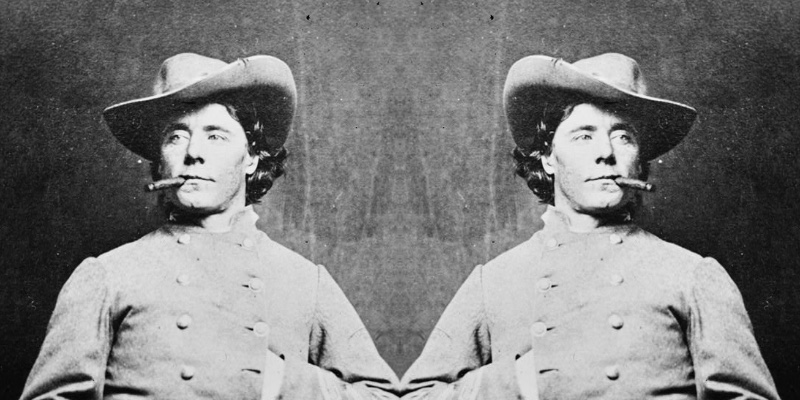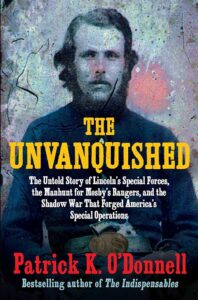Jack Sterry sat astride the crossroads of history; at the right time and right place, he tried to shape the course of events by his actions. Sterry was part of an extraordinary group of men. Often referred to as Jessie Scouts, they were named after the wife of Major General John Charles Frémont, an explorer and a politician who was a US Senator from California and the first presidential candidate for the Republican Party in 1856. At the start of the Civil War, Frémont was a general officer in command of the Department of the West. Known as “the Pathfinder” for his pioneering missions that explored and mapped the West while fending off hostile Native Americans, Frémont organized the specialized group of operators at the beginning of the war in St. Louis and employed them in Missouri, which was embroiled in guerrilla fighting.
His wife, Jessie Ann Benton Frémont, was the daughter of a US senator. The flaxen-haired beauty grew up at her father’s side, rubbing elbows with politicians and sharing his political views, including becoming an outspoken advocate against slavery. Brilliant, powerful, charismatic, and a tremendous advocate for her husband, one admiring journalist of the time dubbed Jessie not only a “historic woman but the greatest woman in America.” In many circles, it was known Jessie “was the better man of the two.” Reportedly, she first advised her husband’s Scouts to wear their enemies’ uniforms. “Jessie, who had been with her husband until lately, frequently saw these men and became very popular with them. Hence their present attachment to her. They swear by her and wear her initials on their coats, inserted in a very modest but coarse style.” In addition to embroidering her initials, they also adopted Jessie as their namesake.
When John Charles Frémont moved east in the spring of 1862 to take command of the Mountain Department, located in southwest Virginia and what would become West Virginia, he brought men who understood rugged terrain and an enemy skilled in guerrilla fighting. The taming of the American West and conflict with Native Americans, including the adaptation of some of their fighting tactics, would have a profound impact on the foundations of American special operations and unconventional warfare. One contemporary stated that the Pathfinder “proceeded to follow his notion derived from experience in the Western frontier. He knew that the safety and efficiency of his army in a wild, wooded, and rugged region depended on the accuracy with which he received information of the plans and movements of the enemy. He at once called around him a set of Western frontiersmen, who had served all through the campaign in Missouri. Some had been in the border wars of Kansas; some served long years on the Plains, hunting the buffalo and the Indian; men accustomed to every form of hardship, thoroughly skilled, not only in the use of the rifle, but drilled in all cunning ways and devices to discover the intentions, position, and strength of a foe. The best of these men were selected and placed in a small organization called the Jessie Scouts.”
One of the Jessie Scouts’ mentors, and an original member, was “Old Clayton, who had come with General Frémont from the West.” Old Clayton developed his survival skills while exploring the American West with Frémont and contending with hostile Native Americans. As chief scout and trainer of raw recruits, “he conceived a great fancy for ‘the boys’ and gave them a deal of advice and instruction.”
Commonly known in camp as Clarence Clayton, but also Chatfield Hardaway, Old Clayton could not only give advice to colleagues but also serve up tactical acumen to their opponents. One such incident occurred in the fall of 1862. When scouting in a Confederate uniform in advance of a large Union cavalry force, he saw a lighted house on the side of the road. When he approached the dwelling, a Confederate picket challenged him. Clayton coolly responded that he was a friend.
When Clayton bantered with the picket, the soldier revealed he was with a Confederate cavalry unit. Suddenly, nine men, including a Rebel officer, darted out of the house onto their saddles and confronted Clayton with their cocked revolvers. The Confederate officer demanded to know his identity. The wily scout informed the Confederate officer that he was a scout of Captain Duval’s Confederate Cavalry, and they were riding to reinforce a certain Confederate cavalry colonel. The Jessie Scout was told that the very officer he was going to reinforce was standing before him.
“Captain Duval will be overjoyed to meet [you],” Clayton convincingly responded.
According to a contemporary account, “At that moment the cavalry came down the road, and while the Colonel and his men were covering the scout,” Clayton called for the captain to come over and calmly introduced him to the Confederate colonel. The Union captain and his men surrounded the Southerners and “very coolly asked them for their arms.” Old Clayton then “apologized for practicing the ruse to save his life.” The Rebel colonel reportedly then “asked for a knothole to crawl into, remarking that he had been sold too cheap.”
Members of the US Army, civilians, and later even a turncoat former Confederate cavalry trooper, the Scouts morphed into the enemy, taking on their uniforms, accents, and mannerisms: “He seems a Tennessean, a Georgian, an Irishman, a German—anything indeed but what he really is,” recalled one contemporary. To pass off as Confederates, the Jessie Scouts developed false backgrounds for men they impersonated and learned convincing cover stories to pass themselves off as the enemy. They began wearing white scarves knotted around their necks in a particular way in order to identify each other behind the lines. Jessie Scouts also developed a stilted coded conversation to identify friend from foe.
Scout One: “Good morning.”
Scout Two: “These are perilous times.”
Scout One: “Yes, but we are looking for better.”
Scout Two: “To what shall we look?”
Scout One: “To the red and white cord.”
They developed the exchange deliberately so that it could not be guessed.
By the summer of 1862, the group numbered roughly two dozen men, including three Scouts recently captured and executed by Confederate troops. Considered spies for wearing the enemy’s uniform, they faced death if they fell into enemy hands.
Their first commander, Captain Charles Carpenter, was initially a fitting leader for this handpicked group: “He was by no means a figure to be passed by. Fancy a poacher who is half brigand and wholly daredevil, and you catch a glimpse of his air. His high-topped velvet boots are drawn up over his wide velvet trousers. No vest is worn, and the expanse of a broad chest affords a fine field for the once snowy shirt-bosom of Parisian pretensions and fine material.” Dark haired, blue eyed, five feet six, and “sinewy and ready for a fight, fun, or frolic, [Carpenter] mingled his dash and boldness with remarkable prudence and caution.” Armed with a Colt and a breechloading rifle for distance shooting, Carpenter bragged he was a crack shot at more than a quarter of a mile. Trappings and appearance aside, at his core, Carpenter ardently hated slavery and told one reporter a tall tale that he was a member of John Brown’s party that attacked the Harpers Ferry arsenal in 1859 “by crawling through a long culvert, or covered drain, which led from the famous engine-house to the river. The Captain does not love the slave lords,” the journalist wrote after interviewing Carpenter.
When not adorned in velvet and gold chains, daredevil and gloryhound Carpenter had sneaked into Confederate Fort Donelson in Tennessee in early February 1862 wearing a Confederate uniform, masquerading as an enemy officer: “I went into Fort Henry two days before the attack on it and brought General Grant an accurate account of the position and number of the Rebel forces and defenses,” he later recalled to a journalist. “I have General Grant’s letter certifying to that. Also, I went into Fort Donelson, while our troops lay at Fort Henry. I went in there in Confederate uniform; and I have General McClernand’s letter to show that I brought him information that proved to be accurate. On my way out a cavalry force passed me, while I lay by the roadside; and its commander told one of his men to leave a fine flag, which he feared would be torn on the way. The flag was stuck into the road, that a returning rebel picket might carry it in. But I got it, wrapped it around my body, and rode into Fort Henry with it.”
Carpenter’s information gleaned while posing as a Confederate no doubt had a role in the battle for Fort Donelson waged between February 11 and 16, 1862. The capture of the fort opened the Cumberland River as a route of invasion into the South. Brigadier General Ulysses S. Grant forced General Simon Bolivar Buckner to accept terms of unconditional surrender, earning Grant the immortal nickname “Unconditional Surrender” Grant.
A master of disguise, Carpenter once wore a woman’s dress to execute a clandestine mission: “Once [I] Rode down to the Rebel pickets at Wilson Creek, dressed as a woman to deliver a letter . . . and this trip was made because ‘the General’ wanted to know precisely the position of part of the Rebel lines.” Not so lucky, other members of Carpenter’s command were sometimes captured by Union forces. One Jessie Scout was initially arrested for being an enemy spy, “James Alexander, who was arrested in the uniform of a [Confederate] Captain of Cavalry, was released yesterday. Finding him to be one of the Jessie Scouts, as he reported.”
Ingenuity was a hallmark of the Scouts, who often had to perilously improvise on the job. They were selected for their aplomb, audacity, valor, and intelligence, “special faculties born in some few men,” wrote one contemporary author.
___________________________________
Excerpted from The Unvanquished © 2024 by Patrick K. O’Donnell. Reprinted with the permission of the publisher, Atlantic Monthly Press, an imprint of Grove Atlantic, Inc. All rights reserved.
Featured image: Captain William J. Lawton, one of the Jessie Scouts


















